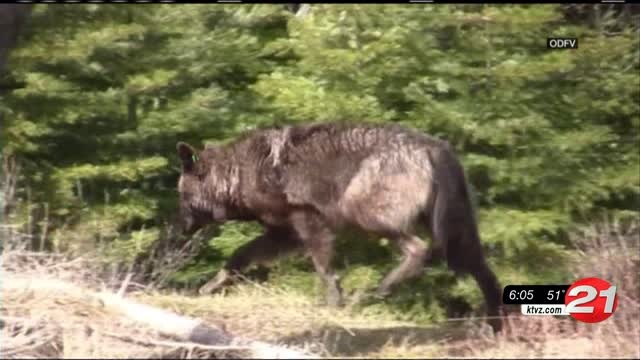Inslee seeks to reduce number of wolves killed in Washington

SPOKANE, Wash. (AP) — Washington Gov. Jay Inslee is seeking ways to reduce the number of wolves killed by the state.
Inslee sent a letter Tuesday to the Department of Fish and Wildlife saying the statewide wolf management plan does not appear to be working in the Kettle River Range area of Ferry County, where the state has killed about two dozen wolves that were preying on cattle.
His efforts come as wildlife experts say the vast majority of the predators are causing no trouble.
The Ferry County situation is unique, experts said. “About 90% of wolf packs are co-existing in our state without livestock conflicts,” the agency said in a statement.
The Kettle River Range is different because the lush, steep terrain is ideal wolf habitat that is also shared with large cattle ranches, making predation an issue.
“The forest conditions and livestock operations in this particular landscape make it extremely challenging, and unfortunately, has resulted in repeated lethal removal actions,” according to Fish and Wildlife. “Something has to change to reduce the loss of both wolves and livestock in this area.”
No immediate changes are contemplated, but there will be discussions in coming weeks to consider possible reforms, said Staci Lehman, a spokeswoman for the agency.
Many ranchers hire range riders to move among cattle in an effort to keep wolves away. The carcasses of dead cattle are also removed in an effort to keep wolves from herds. Lights are also used to scare away wolves.
The state’s killing of wolves in Ferry County, mostly to benefit one ranch in the area, has outraged wolf advocates, who say the state is repeatedly destroying wolf packs living in prime habitat.
Inslee asked the agency to devise a new management approach for that area and report back to him by Dec. 1.
Wolves were all but wiped out in Washington by the 1930s, mostly at the behest of ranching interests.
The animals started moving back into Washington in 2008 from neighboring Idaho and British Columbia. Gray wolves have since come into regular conflict with ranchers.
That has prompted state officials to eliminate numerous wolf packs in recent years.
But the return of wolves enjoys broad support among environmental groups and many residents, especially in the Seattle area, who oppose the killing of the animals.
Inslee noted that regular killing of wolves has “resulted in public concern and outrage.”
State Rep. Joel Kretz, R-Wauconda, whose district includes much of wolf country, said ranchers in the area have worked hard to develop non-lethal means of keeping wolves away from cattle.
“But when it doesn’t work, you have to do something,” Kretz said.
The vast majority of the estimated 126 wolves in the state live in remote northeastern Washington, Kretz said. Most of the rest live in other parts of eastern Washington, although there have been signs of wolves moving into western Washington.
“I get concerned when the people managing wildlife are from Olympia,” rather than the local area, Kretz said. “There are no wolves in Bellevue.”
Environmental groups cheered the governor’s letter.
“Killing off wolves and packs one by one has been the wrong strategy for the state in managing occasional wolf-human conflicts,” said Wayne Pacelle, president of The Center for a Humane Economy.
The state killed all eight members of the Old Profanity Territory wolf pack in Ferry County in August even as the environmental group was winning a court injunction to delay the extermination, Pacelle said.
Inslee’s letter “is a huge step forward for the protection of Washington’s wolves,” said Amaroq Weiss of the Center for Biological Diversity.
Conservation Northwest noted that Washington kills off relatively few wolves, compared with neighboring states. “However, we agree with Gov. Inslee that more work is needed in certain areas,” the organization said.
The state wolf population was estimated in 2018 at a minimum of 126 animals, in 27 packs.
The state in the past seven years has killed a total of 30 wolves for conflicts with livestock, Weiss said.
The Department of Fish and Wildlife has also ordered the killing of wolves in the Togo and Grouse Flats packs, in eastern Washington, for preying on cattle.
Many more wolves are killed in Montana, Idaho and Wyoming, but those states have many more wolves living within their borders, Weiss said.
In Washington, gray wolves are no longer listed as an endangered species under federal protection in eastern Washington. They are still federally protected across the rest of the state, although the federal government is considering lifting those protections.
AP Only 2019